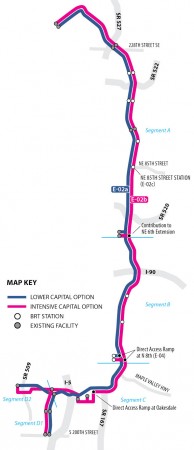Why Don’t ST Reliability Investments Score Higher?
 Among the most interesting results of Sound Transit's BRT studies was essentially no ridership benefit from "high investment" BRT options that spent more to dedicate right-of-way for buses.
Among the most interesting results of Sound Transit's BRT studies was essentially no ridership benefit from "high investment" BRT options that spent more to dedicate right-of-way for buses.
I asked ST spokesman Geoff Patrick if the ridership model gave a bonus to routes that were more reliable. All models have to ignore certain effects, but omitting this one would have drastic implications for the computed value of bus capital investment.
The short answer is that the models do account for it, but perhaps not as much as someone like me might like. ST's ridership model takes travel time as an input, and in general a bus with priority treatments will go faster. Moreover, the model assesses a higher ridership penalty for waiting time when compounded by uncertainty about the next arrival. However, specifics of the study corridors negate this time advantage.
In the case of 145th, the short distance means the potential time difference is small. Priority treatments like signal priority and queue jumps will make the usual time difference vs. a true bus lane negligible. And of course the vast majority of the route, on SR 522, will have dedicated lanes.
Meanwhile, on I-405 the investment is used to change the route, not make it faster. The high-investment scenario would add stops, and serve Tukwila Sounder and the planned dense neighborhood at Southcenter. These deviations increase end-to-end travel time enough to reduce ridership just as much as the new destinations increase it. Regrettably, the Southcenter plan doesn't include Bus option "B2", which would get buses out of Southcenter muck with the addition of a single on/off ramp.
This is somewhat ironic given Sound Transit's primary purpose is to build 100% dedicated right of way, mostly light rail and commuter rail, without forcing every block of those alignments to justify those investments with a traffic study. On the other hand, new ROW is expensive, and the choice to use BRT is in practice a choice to cut costs and sacrifice reliability.
Although I don't have a mathematical model to point to, one of the great things about truly dedicated ROW is that it reduces tail risk. When 145th st backs up because of an accident on I-5, one bus configuration will proceed with minimal delay and one will collapse in congestion. There's no single answer for how much that peace of mind is worth. Some insist on grade separation; others will take the usually-good-enough priority treatments. For me, true dedicated right of way is the threshold between reliable transit, and not.